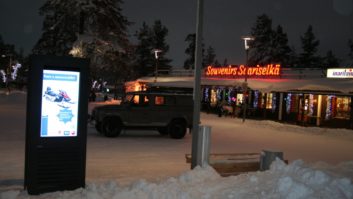
As technology becomes progressively more capable, we find new ways of using it and new places to deploy it. As Ian McMurray discovers, that can take manufacturers and installers into tricky territory.
For those of us who have grown up during the computing revolution, perhaps one of the most startling developments has been the advent of fantastically resilient electronics. Time was, if you moved a computer, you’d better have arranged for an engineer to fix it when it got to its new location. Now, we expect to be able to sit on our mobile phones; throw our laptops on the back seat of the car; take our tablets to the beach.
But try leaving any of those consumer devices in direct sunlight for more than a brief period. Or immersing it in the bath. Or dropping it on a hard floor. Extremes of heat and cold, the probability of water ingress and the threat posed by contaminants are, however, becoming increasingly common challenges for the AV industry as customers look to leverage the technology in the most daunting of environments.
“We installed an LED wall in a water park in the Middle East,” notes Jonathan Cooper, business development consultant, NEC Display Solutions Europe. “The system has to withstand extreme daily temperature shifts, salt water and humidity.”
“One example we have seen a number of times involves architectural lighting for ski lodges, theme parks and so on in far north geographies that get several feet of snow during winter months,” adds Bradford Benn, solutions manager, Harman Professional Solutions. “In these cases, devices such as in-ground washes can end up under snow for several months at a time. This can cause the temperature around the fixture to drop quite low.”
Sun, rain, salt, humidity
“The harshest environment is undoubtedly marine, where sun, rain, salt and extreme temperature and humidity changes are all factors,” rejoins Jason Baird, research and development director at Martin Audio. “Overcoming those challenges for the products we have installed in such an environment took a considerable amount of engineering and also testing.”
Dikran Tawitian, head of marketing and sales at Infinitus Outdoor has, unsurprisingly, given the nature of his company’s business, many war stories. “We have a site within the Arctic Circle in Sariselka, Finland that needed to cope with extremes of cold, snow covering – which eventually melts – and long days of sunshine. In Qatar, another system is challenged by heat and microscopic dust particles. At the nuclear plant in Dounreay, Scotland, proximity to the coast means salt water is always trying to destroy both the electronics and the enclosure. In another installation in the Adriatic port of Split, humidity, a salty atmosphere and heat are real threats.”
“Our enclosures are installed across the globe, from the frozen north to the tropics and deserts,” smiles Tim Burnham, president of Tempest. “One such example is our work at the Burning Man Festival in the Black Rock Desert, where the installation was able to withstand extreme heat and protect against sand ingress, dust storm damage and the unpredictable storm cells that strike this part of Nevada. The harsh desert conditions were a great test of our Blizzard enclosures, which protected eight Christie Roadster projectors.”
Click the link to the next part, which explores what audio and display manufacturers are doing differently to cope with the harshest environments.
www.harman.com
www.infinitus-outdoor.com
www.martin-audio.com
www.nec-display-solutions.com
www.tempest.biz







